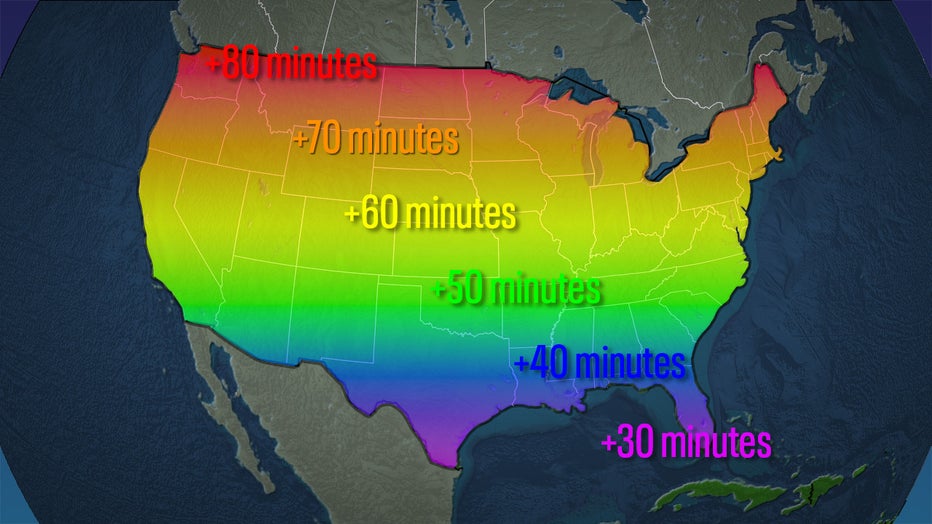See how much more daylight we'll add in February
History of daylight saving time
Daylight saving time, or DST, was formally introduced in the U.S. in 1918 during World War I.
The period within a few weeks of the winter solstice in late December is the darkest time of the year for the U.S.
But daylight hours have been gradually lengthening.
In January, the change was barely noticeable, with only a few extra seconds of sunlight each day. But, by February, the pace picks up dramatically.
For regions farther north, closer to the poles, this shift becomes much more pronounced, while areas closer to the equator experience a gentler transition.
Cities in Northern US could see more than an hour of extra daylight
By the numbers:
In Seattle, the amount of sunlight drastically increases to nearly three minutes each day. By Feb. 28, the sun is above the horizon for 87 minutes longer than it was on Feb.1.

The sun rises behind the skyline of lower Manhattan in New York City on December 25, 2023, as seen from Jersey City, New Jersey. (Credit: Gary Hershorn/Getty Images)
In comparison, Miami, which is much closer to the equator, sees an increase of only 37 minutes of sunlight throughout the month.
What they're saying:
"The observed paths of the sun will vary from observer to observer depending to their position on the planet," U.S. Naval Observatory told FOX TV Stations, adding that there are "more ‘drastic’ effects observed the further away from the equator" over time with the seasons.
This means that days are getting longer and the nights are getting shorter, resulting in earlier sunrises and later sunsets.
Days will continue to grow longer and nights will progressively get shorter across the Northern Hemisphere until the summer solstice on June 20.
February daylight gained in major US cities

Graphic showing the daylight gained in the month of February.
Seattle: 87 minutes longer
San Francisco: 60 minutes longer
Los Angeles: 52 minutes longer
Phoenix: 51 minutes longer
Austin: 45 minutes longer
Minneapolis: 78 minutes longer
Chicago: 70 minutes longer
Dallas: 50 minutes longer
Houston: 44 minutes longer
Milwaukee: 73 minutes longer
Detroit: 71 minutes longer
Atlanta: 52 minutes longer
Tampa: 41 minutes longer
Orlando: 41 minutes longer
Washington D.C.: 63 minutes longer
Philadelphia: 65 minutes longer
New York: 67 minutes longer
Daylight saving time 2025
What we know:
Daylight saving time is set to begin on Sunday, March 9, 2025. In the early hours, time will jump forward by one hour from 2 a.m. to 3 a.m. This marks the shift to local Daylight Saving Time (DST)
RELATED: Eliminating daylight saving time could mean dramatic changes to sunrise, sunset times
The shift will result in later sunsets, which can benefit outdoor businesses that rely on daylight, such as golf courses.
Weather in February
Dig deeper:
While the general expectation is for the second month of the year to be warmer than average, with near-normal precipitation in most areas, there are important regional caveats to monitor, according to FOX Weather.
The best chances for warmer weather will be in the southern U.S., while the Pacific Northwest and communities along the US-Canadian border are more likely to see additional rounds of below-average readings.
In terms of precipitation, the Pacific Northwest and Midwest are expected to see above-average accumulations, while Texas and the Southeast are likely to experience drier-than-normal conditions.
Historically, February is the second-coldest month of meteorological winter and has been known to produce significant winter storms, but none are on the horizon in the short and medium term.

